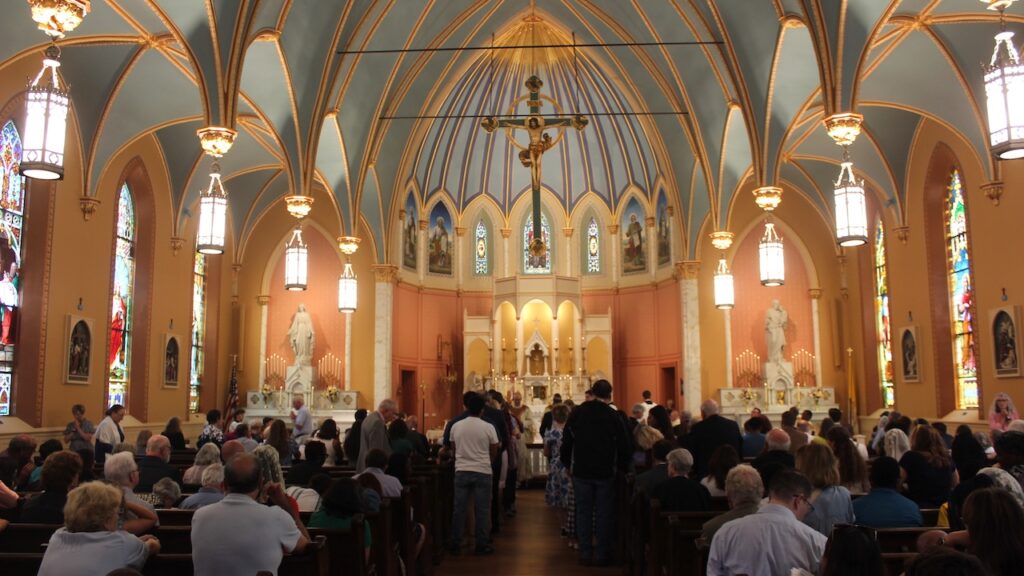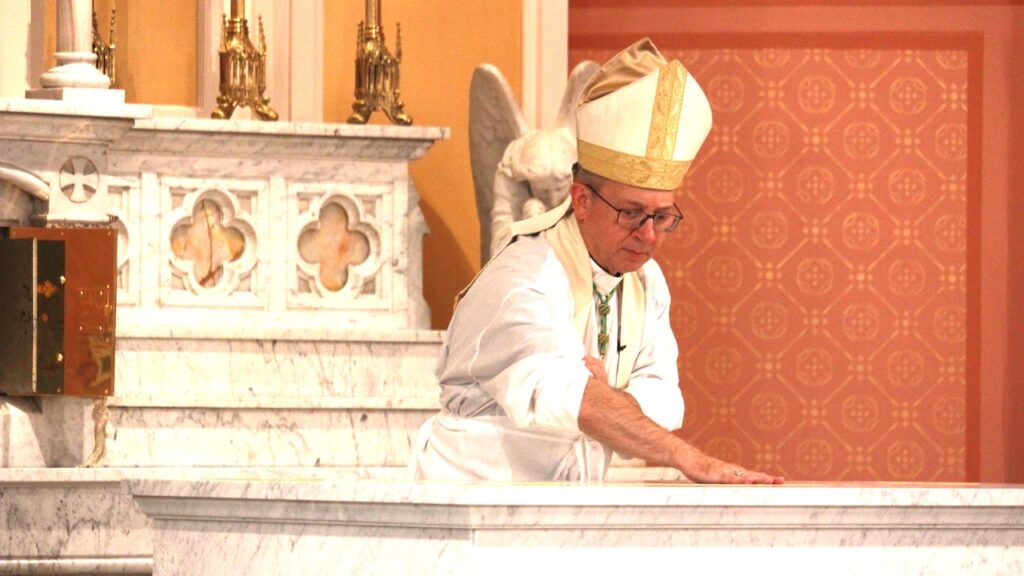Passing a ruined shrine, the man later canonized St. Francis of Assisi heard the Lord tell him, “Rebuild my church.”
The Catholic community in Staunton has been obeying that command since its days as a mission named for the saint in 1844 – from the construction of the first church in 1851, to the current building in 1885, to extensive interior renovations about 30 years ago, to repairs to the green limestone exterior about eight years ago.
With Bishop Barry C. Knestout presiding, the parish of St. Francis of Assisi, Staunton, celebrated its most recent project on Sept. 1. The concelebrants included the pastor, Father Matthias Lusembo; former pastor Father Joseph Wamala, now pastor of St. Edward the Confessor, Richmond; and Father Silvio Kaberia, episcopal vicar of the Western Vicariate and pastor of Blessed Sacrament, Harrisonburg.
The $2.7 million renovation of the nave and sanctuary is an example of those seasons of renewals like Advent and Lent, the bishop said, that lead to “the deepening of our faith and richness of understanding of all that God has done for us.”
Some 300 parishioners watched the bishop bless the baptismal font, relocated to an alcove off the vestibule, and anoint the white marble altar in the sanctuary.
“To the extent that we could create, with this renovation, a place where it generates an increase in reverence and … a place suitable to give praise and thanksgiving to our Lord, that was the primary objective above and beyond anything else,” said the project architect, Matt Fitzgerald.
The creation of the new interior started in July 2023, following more than two years of planning and fundraising.
“People have been very generous,” Father Lusembo said. “Very generous, not only with money, but also with their time, their energy. And they have been praying for the project all the time.”
As liturgies moved to the parish social hall, workers from Harman Construction Company in Harrisonburg put plywood over stained glass windows and the altars dedicated to the Blessed Virgin Mary and St. Joseph on either side of the sanctuary. They removed the pews for refurbishing, laid a new wood floor, erected scaffolding to give painters and plasterers access to the ceiling and walls, and installed new lighting.
The vestibule now has seven murals depicting the life of St. Francis. The walls behind the statues of the Virgin Mary and St. Joseph and in the sanctuary are a light rose. The ceiling of the apse became a deep blue, with rays of gold leaf circling the suspended crucifix.

For longtime parishioners like Priscilla Jenkins, understanding and awareness of the meaning behind many of these changes has deepened. A cradle Catholic, Jenkins said she was used to seeing a baptismal font at the entrance to a church, and confessionals in the back of the nave, without knowing the reason.
“I learned that this is a reminder that every time you walk through the door you come into faith through baptism,” she said. “The fact that we have returned our confessional to its rightful space – know that before you truly step into this space, you’ve got to clean out your soul. In that way, you’re cleansed and able to really listen to the Word.”
The centerpiece of the ceremony was the anointing and dedication of the new altar, made of one ton of Carrara marble, with onyx marble accents and a polished brass IHS symbol on the front. The bishop took off his chasuble and tied on a linen apron, a “gremiale.” After pouring holy chrism on the altar, the bishop reverently rubbed the oil into it, walking around to make sure he touched all four corners.
“The altar symbolizes not only the table of sacrifice, but also the tomb where Christ was buried and from which he rose from the dead,” the bishop said in his homily. “The altar reminds us of the sacrifice of Christ and the new life he gives us by our own share in the Eucharistic banquet.”
The bishop said that the oil is a symbol of the Holy Spirit, a reminder of our full initiation into the Church through confirmation, “and the coming of the Spirit which inspires us and calls us to go out into the world, beyond this place, to bring the message of faith and reconciliation to those we encounter.”
Using a cloth to protect his hands, an altar server placed a brazier in the center of the altar, smoke from the incense pouring aloft, symbolizing Christian prayer.
“May our worship be a fragrant aroma in which God rejoices,” the bishop said at the close of his homily. “And may this space be a worthy expression of the glory of God.”

A psalm, motet or hymn punctuated every part of the celebration. Hired about 18 months ago, music director Benjamin Geier said after Mass that he began building up his singers months before the rebuilding projected started.
He had been giving free voice lessons to the “stay-at-home moms who homeschool, lawyers, construction workers, just regular folks,” who make up the choir.
Geier said he told them, “Just be fearless and really let your voice loose. And they really did it today, I’m so proud of them.”
The morning had been cloudy, but by the end of the liturgy, the sun had emerged, as people gathered for the annual parish picnic and reflected on the sights and sounds of their faith.
“It was very easy to close your eyes and imagine being surrounded by angels and saints,” said parishioner Anna Ridenour. “We need to be surrounded by truth, by beauty, by goodness and we have been gifted by a parish, by a Church, by their blood, sweat and tears, and monetary efforts.”
Ridenour’s husband, Greg, said he appreciates the detail of the artwork and the new elevated altar.
“Even when your mind wanders and shouldn’t, there’s still something beautiful to see,” he said.
A member of the parish for about 25 years, Duane Landry said that each time he walks into this historic church, he feels the presence of God.
“The history is certainly important, but it’s not the main thing,” said Landry. “The main thing is the faith.”
Parishioner Shauna Elzroth echoed that, saying “We’re learning from each other and from the Mass to be true Christians walking through Christ.”
About 240 households have contributed or pledged money for the project, as the people who attend St. Francis of Assisi continue to renew their faith and their church on a hill overlooking the city of Staunton.

